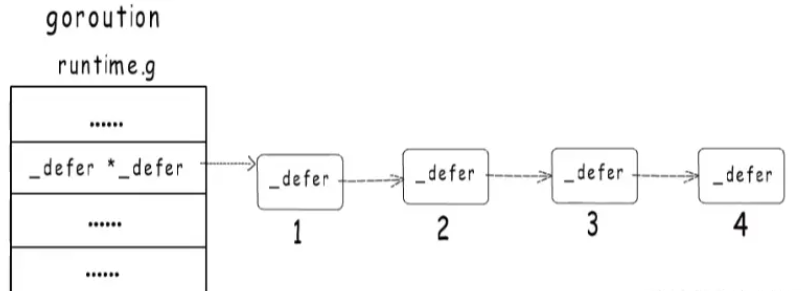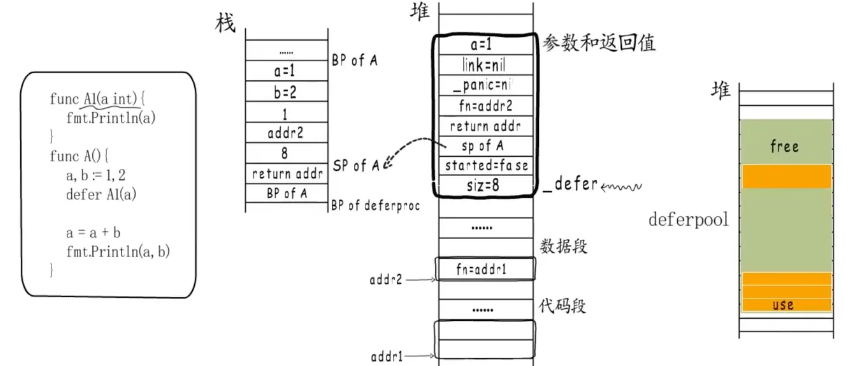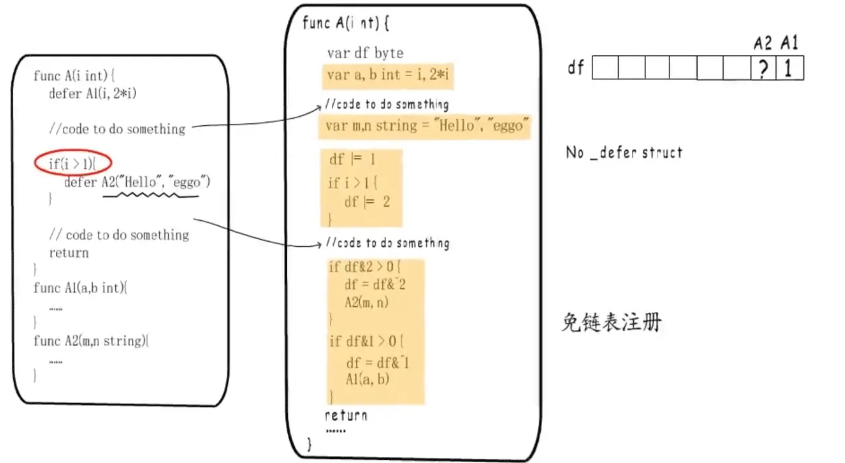您好,登錄后才能下訂單哦!
您好,登錄后才能下訂單哦!
今天小編給大家分享一下Golang的關鍵字defer如何使用的相關知識點,內容詳細,邏輯清晰,相信大部分人都還太了解這方面的知識,所以分享這篇文章給大家參考一下,希望大家閱讀完這篇文章后有所收獲,下面我們一起來了解一下吧。
在defer出現的地方插入了指令CALL runtime.deferproc,在函數返回的地方插入了CALL runtime.deferreturn。goroutine的控制結構中,有一張表記錄defer,調用runtime.deferproc時會將需要defer的表達式記錄在表中,而在調用runtime.deferreturn的時候,則會依次從defer表中“出棧”并執行
如果有多個defer,調用順序類似棧,越后面的defer表達式越先被調用
defer信息會注冊到鏈表,當前執行的 goroutine 持有這個鏈表的頭指針,每個 goroutine 都有一個對應的結構體struct G,其中有一個字段指向這個defer鏈表頭
type g struct {
// Stack parameters.
// stack describes the actual stack memory: [stack.lo, stack.hi).
// stackguard0 is the stack pointer compared in the Go stack growth prologue.
// It is stack.lo+StackGuard normally, but can be StackPreempt to trigger a preemption.
// stackguard1 is the stack pointer compared in the C stack growth prologue.
// It is stack.lo+StackGuard on g0 and gsignal stacks.
// It is ~0 on other goroutine stacks, to trigger a call to morestackc (and crash).
stack stack // offset known to runtime/cgo
stackguard0 uintptr // offset known to liblink
stackguard1 uintptr // offset known to liblink
_panic *_panic // innermost panic - offset known to liblink
// _defer 這個字段指向defer鏈表頭
_defer *_defer // innermost defer
...
}新注冊的defer會添加到鏈表頭,所以感覺像是棧那樣先進后出的調用:

deferproc一共有兩個參數,第一個是參數和返回值的大小,第二個是指向funcval的指針
// Create a new deferred function fn with siz bytes of arguments.
// The compiler turns a defer statement into a call to this.
//go:nosplit
func deferproc(siz int32, fn *funcval) { // arguments of fn follow fn
// 獲取當前goroutine
gp := getg()
if gp.m.curg != gp {
// go code on the system stack can't defer
throw("defer on system stack")
}
// the arguments of fn are in a perilous state. The stack map
// for deferproc does not describe them. So we can't let garbage
// collection or stack copying trigger until we've copied them out
// to somewhere safe. The memmove below does that.
// Until the copy completes, we can only call nosplit routines.
// 獲取調用者指針
sp := getcallersp()
// 通過偏移獲得參數
argp := uintptr(unsafe.Pointer(&fn)) + unsafe.Sizeof(fn)
callerpc := getcallerpc()
// 創建defer結構體
d := newdefer(siz)
if d._panic != nil {
throw("deferproc: d.panic != nil after newdefer")
}
// 初始化
d.link = gp._defer
gp._defer = d
d.fn = fn
d.pc = callerpc
d.sp = sp
switch siz {
case 0:
// Do nothing.
case sys.PtrSize:
*(*uintptr)(deferArgs(d)) = *(*uintptr)(unsafe.Pointer(argp))
default:
memmove(deferArgs(d), unsafe.Pointer(argp), uintptr(siz))
}
// deferproc returns 0 normally.
// a deferred func that stops a panic
// makes the deferproc return 1.
// the code the compiler generates always
// checks the return value and jumps to the
// end of the function if deferproc returns != 0.
return0()
// No code can go here - the C return register has
// been set and must not be clobbered.
}// 以下是_defer結構體
// A _defer holds an entry on the list of deferred calls.
// If you add a field here, add code to clear it in freedefer and deferProcStack
// This struct must match the code in cmd/compile/internal/gc/reflect.go:deferstruct
// and cmd/compile/internal/gc/ssa.go:(*state).call.
// Some defers will be allocated on the stack and some on the heap.
// All defers are logically part of the stack, so write barriers to
// initialize them are not required. All defers must be manually scanned,
// and for heap defers, marked.
type _defer struct {
// siz 記錄defer的參數和返回值共占多少字節
// 會直接分配在_defer后面,在注冊時保存參數,在執行完成時拷貝到調用者參數和返回值空間
siz int32 // includes both arguments and results
// started 標記是否已經執行
started bool
// heap go1.13優化,標識是否為堆分配
heap bool
// openDefer indicates that this _defer is for a frame with open-coded
// defers. We have only one defer record for the entire frame (which may
// currently have 0, 1, or more defers active).
// openDefer 是否是open defer,通過這些信息可以找到未注冊到鏈表的defer函數
openDefer bool
// sp 記錄調用者棧指針,可以通過它判斷自己注冊的defer是否已經執行完了
sp uintptr // sp at time of defer
// pc deferproc的返回地址
pc uintptr // pc at time of defer
// fn 要注冊的funcval
fn *funcval // can be nil for open-coded defers
// _panic 指向當前的panic,表示這個defer是由這個panic觸發的
_panic *_panic // panic that is running defer
// link 鏈到前一個注冊的defer結構體
link *_defer
// If openDefer is true, the fields below record values about the stack
// frame and associated function that has the open-coded defer(s). sp
// above will be the sp for the frame, and pc will be address of the
// deferreturn call in the function.
// 通過這些信息可以找到未注冊到鏈表的defer函數
fd unsafe.Pointer // funcdata for the function associated with the frame
varp uintptr // value of varp for the stack frame
// framepc is the current pc associated with the stack frame. Together,
// with sp above (which is the sp associated with the stack frame),
// framepc/sp can be used as pc/sp pair to continue a stack trace via
// gentraceback().
framepc uintptr
}defer將參數注冊的時候拷貝到堆上,執行時再(將參數和返回值)拷貝回棧上
go會分配不同規格的_defer pool,執行時從空閑_defer中取一個出來用,沒有合適的再進行堆分配。用完以后再放回空閑_defer pool。以避免頻繁的堆分配和回收

go1.12中defer存在的問題:
defer信息主要存儲在堆上,要在堆和棧上來回拷貝返回值和參數很慢
defer結構體通過鏈表鏈起來,而鏈表的操作也很慢
go1.13中defer的優化:
減少了defer信息的堆分配。再通過deferprocStack將整個defer注冊到defer鏈表中
將一般情況的defer信息存儲在函數棧幀的局部變量區域
顯示循環或者是隱式循環的defer還是需要用到go1.12中defer信息的堆分配
官方給出的性能提升是30%
go1.14中defer的優化:
在編譯階段插入代碼,把defer函數的執行邏輯展開在所屬函數內,避免創建defer結構體,而且不需要注冊到defer鏈表。稱為 open coded defer
與1.13一樣不適用于循環中的defer
性能幾乎提升了一個數量級
open coded defer 中發生panic 或 調用runtime.Goexit(),后面未注冊到的defer函數無法執行到,需要棧掃描。defer結構體中就多添加了一些字段,借助這些字段可以找到未注冊到鏈表中的defer函數
結果就是defer變快了,但是panic變慢了
defer添加了局部變量去判斷是否需要執行,需要執行的話就將標識df對應的位上或一下,如果是有條件的defer,需要根據具體條件去或df

deferprocStack
// deferprocStack queues a new deferred function with a defer record on the stack.
// The defer record must have its siz and fn fields initialized.
// All other fields can contain junk.
// The defer record must be immediately followed in memory by
// the arguments of the defer.
// Nosplit because the arguments on the stack won't be scanned
// until the defer record is spliced into the gp._defer list.
//go:nosplit
func deferprocStack(d *_defer) {
// 獲得當前 goroutine
gp := getg()
if gp.m.curg != gp {
// go code on the system stack can't defer
throw("defer on system stack")
}
// siz and fn are already set.
// The other fields are junk on entry to deferprocStack and
// are initialized here.
// 初始化 _defer 信息
d.started = false
d.heap = false
d.openDefer = false
d.sp = getcallersp()
d.pc = getcallerpc()
d.framepc = 0
d.varp = 0
// The lines below implement:
// d.panic = nil
// d.fd = nil
// d.link = gp._defer
// gp._defer = d
// But without write barriers. The first three are writes to
// the stack so they don't need a write barrier, and furthermore
// are to uninitialized memory, so they must not use a write barrier.
// The fourth write does not require a write barrier because we
// explicitly mark all the defer structures, so we don't need to
// keep track of pointers to them with a write barrier.
*(*uintptr)(unsafe.Pointer(&d._panic)) = 0
*(*uintptr)(unsafe.Pointer(&d.fd)) = 0
*(*uintptr)(unsafe.Pointer(&d.link)) = uintptr(unsafe.Pointer(gp._defer))
*(*uintptr)(unsafe.Pointer(&gp._defer)) = uintptr(unsafe.Pointer(d))
return0()
// No code can go here - the C return register has
// been set and must not be clobbered.
}以上就是“Golang的關鍵字defer如何使用”這篇文章的所有內容,感謝各位的閱讀!相信大家閱讀完這篇文章都有很大的收獲,小編每天都會為大家更新不同的知識,如果還想學習更多的知識,請關注億速云行業資訊頻道。
免責聲明:本站發布的內容(圖片、視頻和文字)以原創、轉載和分享為主,文章觀點不代表本網站立場,如果涉及侵權請聯系站長郵箱:is@yisu.com進行舉報,并提供相關證據,一經查實,將立刻刪除涉嫌侵權內容。